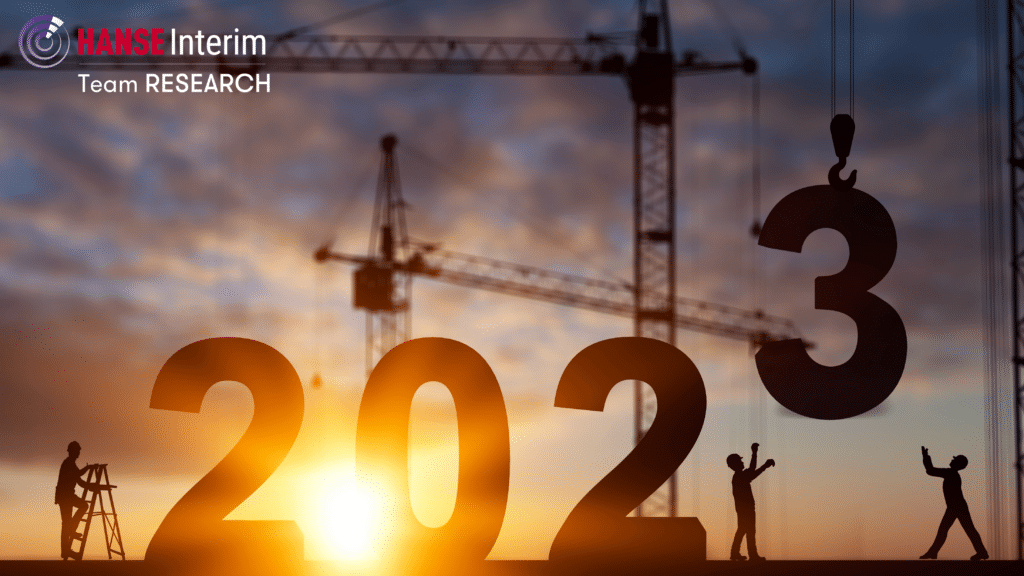HANSE Interim Research Team: Will the effects of the Corona pandemic and increased interest rates cause the construction industry high to collapse?
The construction industry in Germany was able to look back on a successful five years before the outbreak of the Corona pandemic. The European Central Bank’s key interest rate, which has remained at a historic low since March 2016, and an overall robust domestic economy up to spring 2020, accompanied by falling unemployment figures and rising household incomes, supported the domestic construction boom that had continued since the beginning of the past decade and ensured high demand in most areas of the construction industry.

According to data from the market research company IBISWorld, the construction sector is then expected to have recorded declining sales again for the first time in the subsequent years 2021 and 2022.
The background to this development is the negative impact of the coronavirus pandemic, which is spreading to the construction industry with a certain delay.
For example, there were declines in orders in commercial building construction in particular in 2020, which resulted in lower construction output in this construction sector in subsequent years. Increased public-sector construction investment was unable to offset the decline in construction output in commercial construction.
Also having a negative impact since 2021 are material bottlenecks and the associated rise in raw material prices as well as higher energy costs. The outbreak of war in Ukraine has further exacerbated this situation, as Russia and Ukraine are major suppliers of raw materials. In addition, the increases in the key interest rate by the ECB led to a rise in interest rates for construction loans and thus to higher construction costs.
This has led to an increase in order cancellations and construction stoppages.
The number of building permits and new orders in the main construction sector is declining. While rising construction interest rates are limiting the supply of real estate, increased lending rates are simultaneously leading to a lower number of real estate and land purchases. As fewer and fewer consumers can afford to buy property, various studies show that property prices are already falling in some regions of Germany. This can currently be observed above all for older buildings. In contrast, residential rents are rising faster again.
According to IBIS World forecasts, the fundamentally positive development of the construction sector will be able to continue from 2024, although growth is likely to be much less dynamic than from 2015 to 2020. On the one hand, the economic impact of the coronavirus pandemic and the Ukraine war means that a surge in demand for construction services from industry and trade is not expected in the short term; on the other hand, growth in residential construction is likely to weaken due to higher financing costs compared with the previous five-year period.
Sales development in the German construction sector (in EUR billion)

In the short term, a temporary decline in construction volume in the residential construction sector is even expected. By contrast, demand from public sector clients is expected to remain stable overall due to a further increase in infrastructure investment.
Which success factors will be able to play a special role in the future?
The HANSE Research department analyzed the current developments in the market in the course of a project in the HANSE Group and determined:
The most important success factors continued to include the following competencies:
Good project management skills: Construction projects are characterized by complex planning processes in which personnel, material and machine capacities as well as various other parameters must be taken into account. Faulty planning often has negative financial consequences.
Management of externally awarded contracts: Outsourcing construction and planning services to external providers entails risks such as faulty or late execution. The targeted commissioning of reliable subcontractors therefore contributes to the success of the company.
High success rate with previous projects: In addition to price, references are an important criterion in bidding processes. By demonstrating the successful execution of similar orders in the past, companies show that they are suitable for taking on a project.
Well-trained workforce: In many trades in the skilled trades, there are increasing signs of a shortage of skilled workers, so recruiting suitable skilled workers is an important building block for the future success of the company.
Which trends will have a lasting impact on the construction industry in the future?
Various industry experts have evaluated the following topics according to their relevance:
- Technological change is progressing only slowly in the construction industry as a whole. The background to this development is the strong fragmentation of the sector, whose value creation process is characterized by many independent players. The productivity gains attributable to product and process innovations are nowhere near as pronounced in the construction sector as in the rest of the economy. In addition, particularly in the more SME-oriented sectors of the construction industry, only limited financial resources are available for modernizing the companies, so innovations tend to take place at the level of the supplying building materials and construction machinery industry.
- Nevertheless, the trend over the past five years has seen an increase in the complexity of process flows in the construction industry as well, and the demands placed on companies in the planning and execution of construction projects have risen, creating incentives for the introduction of suitable digital planning and coordination tools and automated construction processes.
- These range from new technical possibilities for surveying the construction site with drones and special sensors, to digital planning and documentation tools such as building information modeling software that can be used to create virtual construction models, to the supporting use of highly specialized construction machinery, construction robots and innovative manufacturing processes such as 3D printing, as well as the use of new or more sustainable construction materials such as recycled or carbon fiber concrete.
What developments do you see in this market in the future?
With best regards
Your HANSE Interim Management
Andreas Lau and Christian Heuermann
Sources: HMC Research Department, statista, IBIS World, Press


